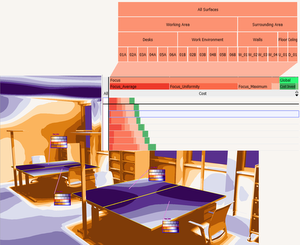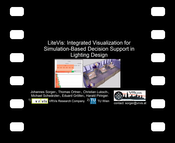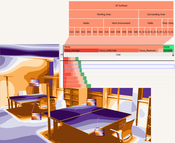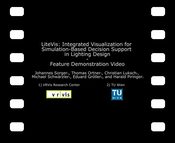Information
- Publication Type: Journal Paper with Conference Talk
- Workgroup(s)/Project(s):
- Date: January 2016
- Journal: Visualization and Computer Graphics, IEEE Transactions on
- Volume: 22
- Number: 1
- Location: Chicago
- Lecturer: Johannes Sorger
- ISSN: 1077-2626
- Event: IEEE Vis
- Pages: 290 – 299
- Keywords: Integrating Spatial and Non-Spatial Data
Abstract
State-of-the-art lighting design is based on physically accurate lighting simulations of scenes such as offices. The simulation results support lighting designers in the creation of lighting configurations, which must meet contradicting customer objectives regarding quality and price while conforming to industry standards. However, current tools for lighting design impede rapid feedback cycles. On the one side, they decouple analysis and simulation specification. On the other side, they lack capabilities for a detailed comparison of multiple configurations. The primary contribution of this paper is a design study of LiteVis, a system for efficient decision support in lighting design. LiteVis tightly integrates global illumination-based lighting simulation, a spatial representation of the scene, and non-spatial visualizations of parameters and result indicators. This enables an efficient iterative cycle of simulation parametrization and analysis. Specifically, a novel visualization supports decision making by ranking simulated lighting configurations with regard to a weight-based prioritization of objectives that considers both spatial and non-spatial characteristics. In the spatial domain, novel concepts support a detailed comparison of illumination scenarios. We demonstrate LiteVis using a real-world use case and report qualitative feedback of lighting designers. This feedback indicates that LiteVis successfully supports lighting designers to achieve key tasks more efficiently and with greater certainty.Additional Files and Images
Additional images and videos
 teaser:
two components of the LiteVis interface, left: the Simulation View, right: ranking of lighting solutions in the Analysis View
teaser:
two components of the LiteVis interface, left: the Simulation View, right: ranking of lighting solutions in the Analysis View
Additional files
Weblinks
BibTeX
@article{sorger-2015-litevis,
title = "LiteVis: Integrated Visualization for Simulation-Based
Decision Support in Lighting Design",
author = "Johannes Sorger and Thomas Ortner and Christian Luksch and
Michael Schw\"{a}rzler and Eduard Gr\"{o}ller and Harald
Piringer",
year = "2016",
abstract = "State-of-the-art lighting design is based on physically
accurate lighting simulations of scenes such as offices. The
simulation results support lighting designers in the
creation of lighting configurations, which must meet
contradicting customer objectives regarding quality and
price while conforming to industry standards. However,
current tools for lighting design impede rapid feedback
cycles. On the one side, they decouple analysis and
simulation specification. On the other side, they lack
capabilities for a detailed comparison of multiple
configurations. The primary contribution of this paper is a
design study of LiteVis, a system for efficient decision
support in lighting design. LiteVis tightly integrates
global illumination-based lighting simulation, a spatial
representation of the scene, and non-spatial visualizations
of parameters and result indicators. This enables an
efficient iterative cycle of simulation parametrization and
analysis. Specifically, a novel visualization supports
decision making by ranking simulated lighting configurations
with regard to a weight-based prioritization of objectives
that considers both spatial and non-spatial characteristics.
In the spatial domain, novel concepts support a detailed
comparison of illumination scenarios. We demonstrate LiteVis
using a real-world use case and report qualitative feedback
of lighting designers. This feedback indicates that LiteVis
successfully supports lighting designers to achieve key
tasks more efficiently and with greater certainty.",
month = jan,
journal = "Visualization and Computer Graphics, IEEE Transactions on",
volume = "22",
number = "1",
issn = "1077-2626 ",
pages = "290--299",
keywords = "Integrating Spatial and Non-Spatial Data",
URL = "https://www.cg.tuwien.ac.at/research/publications/2016/sorger-2015-litevis/",
}


 teaser
teaser


